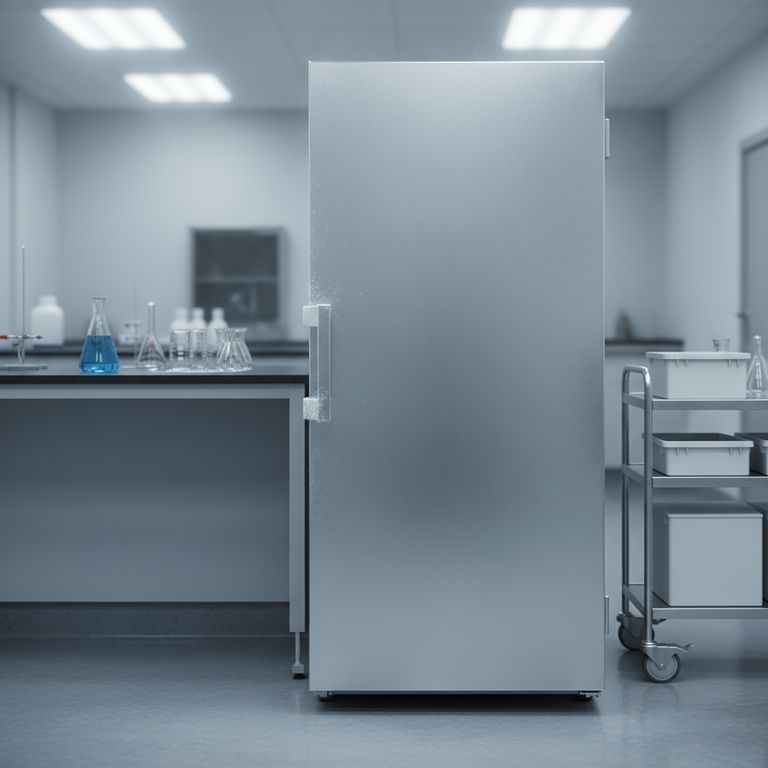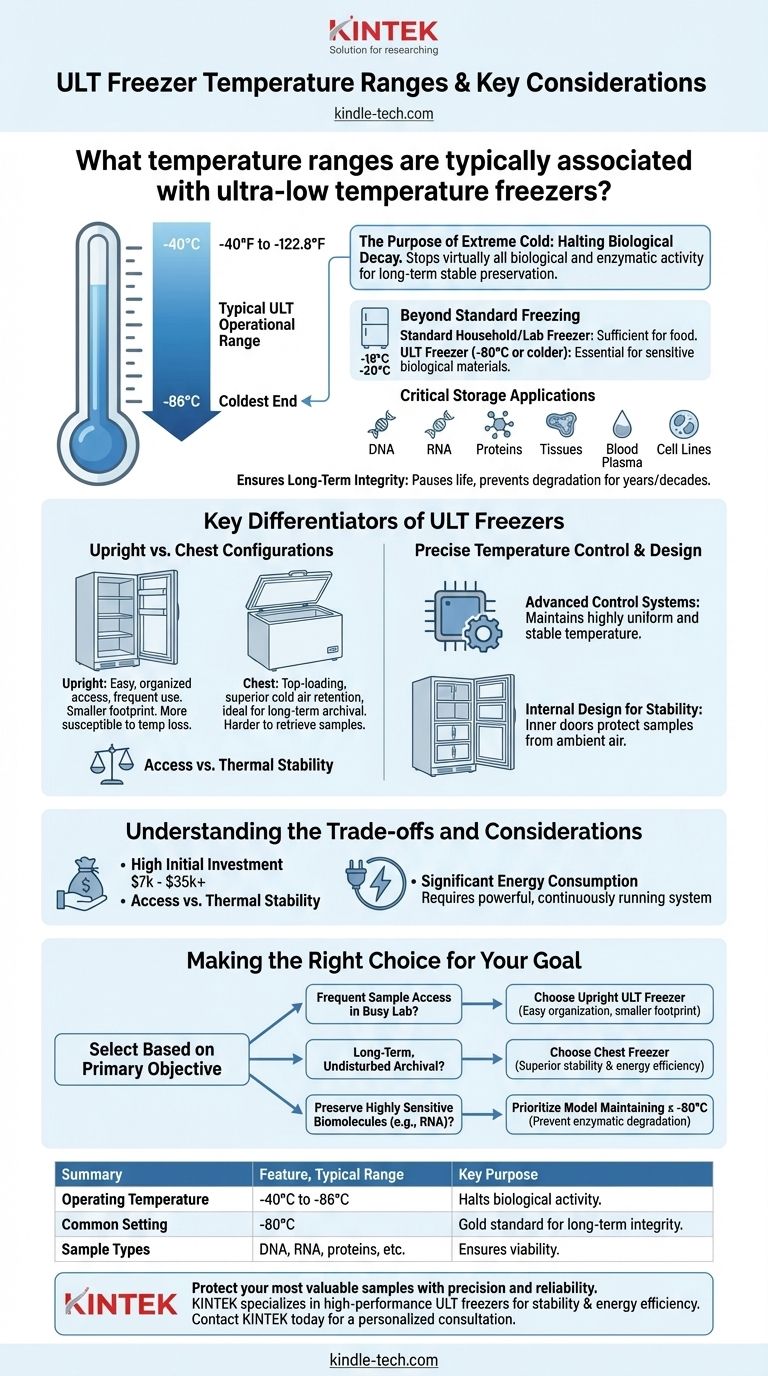Ultra-low temperature (ULT) freezers are specialized refrigeration units designed to maintain temperatures far below those of standard freezers. Their operational range typically falls between -40°C and -86°C (-40°F to -122.8°F), with many models engineered to sustain temperatures at the coldest end of this spectrum for maximum preservation.
The extreme cold of a ULT freezer is not arbitrary; it is a critical requirement for halting virtually all biological and enzymatic activity. This capability is essential for the long-term, stable preservation of sensitive biological samples, ensuring their integrity for future research, analysis, or clinical use.

The Purpose of Extreme Cold: Halting Biological Decay
To understand ULT freezers, it's crucial to understand why such low temperatures are necessary. It is about stopping the molecular clock.
Beyond Standard Freezing
A standard household or lab freezer operates around -18°C to -20°C. While this is sufficient for preserving food, it is not cold enough to stop all enzymatic or molecular degradation in sensitive biological materials over the long term.
Critical Storage Applications
ULT freezers are indispensable in fields where sample integrity is non-negotiable. This includes biomedical research, pharmaceutical development, hospitals, blood banks, and forensic labs.
They are used to store high-value biological samples such as DNA, RNA, proteins, tissues, blood plasma, and cell lines. The ultra-low temperature effectively pauses the life of the sample.
Ensuring Long-Term Integrity
By maintaining temperatures at or below -80°C, these freezers ensure that samples remain in a state of suspended animation. This prevents degradation and preserves their viability and chemical structure for years or even decades, which is critical for longitudinal studies and archival purposes.
Key Differentiators of ULT Freezers
Beyond temperature, ULT freezers are defined by their specific design and engineering features built for stability and reliability.
Upright vs. Chest Configurations
ULT freezers are available in two primary form factors.
- Upright freezers offer easy, organized access with shelved compartments, similar to a standard refrigerator. They are common in labs where samples are accessed frequently.
- Chest freezers are top-loading units. They are better at retaining cold air when opened and are often preferred for long-term, undisturbed archival storage.
Precise Temperature Control
These are not just cold boxes; they are precision instruments. ULT freezers feature advanced control systems that maintain a highly uniform and stable temperature throughout the internal chamber, minimizing fluctuations that could harm samples.
Internal Design for Stability
To further combat temperature loss during access, most upright ULT freezers include shelves enclosed by individual inner doors. This design means opening the main door only exposes a single compartment to ambient air, protecting the rest of the stored materials.
Understanding the Trade-offs and Considerations
While essential, ULT freezers represent a significant investment in terms of cost and operational resources. An objective assessment requires looking at their downsides.
High Initial Investment
The specialized technology required for ULT freezers comes at a price. Costs can range from approximately $7,000 to over $35,000, depending on the freezer's size, features, and temperature capabilities.
Significant Energy Consumption
Maintaining a temperature gradient of over 100°C from the ambient environment requires a powerful, continuously running refrigeration system. This results in substantial energy consumption, making it a notable operational expense.
Access vs. Thermal Stability
The choice between an upright and a chest model presents a direct trade-off. Upright models offer superior convenience and organization but are more susceptible to temperature loss when opened. Chest freezers are more thermally efficient but can make retrieving specific samples more difficult.
Making the Right Choice for Your Goal
Selecting a ULT freezer involves balancing application needs with practical constraints. Your decision should be guided by your primary objective.
- If your primary focus is frequent sample access in a busy lab: An upright ULT freezer is typically the most practical choice due to its easy organization and smaller physical footprint.
- If your primary focus is long-term, undisturbed archival of critical samples: A chest freezer offers superior temperature stability and energy efficiency, making it ideal for safeguarding materials for years.
- If your primary focus is preserving highly sensitive biomolecules like RNA: You should prioritize a model that can reliably maintain temperatures at or below -80°C to prevent any potential for enzymatic degradation.
Ultimately, understanding these core principles empowers you to select a solution that truly protects your most valuable assets.
Summary Table:
| Feature | Typical Range | Key Purpose |
|---|---|---|
| Operating Temperature | -40°C to -86°C (-40°F to -122.8°F) | Halts biological/enzymatic activity |
| Common Setting | -80°C | Gold standard for long-term sample integrity |
| Sample Types | DNA, RNA, proteins, tissues, blood, cell lines | Ensures viability for research and diagnostics |
Protect your most valuable samples with precision and reliability. Choosing the right ultra-low temperature freezer is critical for the integrity of your biological materials. KINTEK specializes in lab equipment and consumables, serving laboratory needs with high-performance ULT freezers designed for stability and energy efficiency. Let our experts help you select the ideal model for your application—whether for frequent access or long-term archival. Contact KINTEK today for a personalized consultation and ensure your research is built on a foundation of uncompromising sample preservation.
Visual Guide

Related Products
- 58L Precision Laboratory Ultra Low Temperature Upright Freezer for Critical Sample Storage
- 108L Vertical Ultra Low Temperature ULT Freezer
- 508L Advanced Vertical Ultra Low Temperature Freezer for Critical Laboratory Storage
- 408L Advanced Vertical Laboratory Ultra Low Temperature Freezer for Critical Research Material Preservation
- 708L Ultra Low Temperature Freezer High Performance Laboratory Freezer
People Also Ask
- How do Ultra-Low Temperature freezers ensure the integrity of microbiological samples? Maintain Stability for Critical Research
- What temperature range do Ultra-Low Temperature freezers maintain? The -80°C Standard for Sample Integrity
- What are the common designs of ultra-low temperature freezers? Upright vs. Chest Models for Your Lab
- What are ultralow temperature freezers and what are they used for? Preserve Critical Samples for Decades
- What factors should be considered when selecting an ultra-low temperature freezer? Ensure Sample Integrity and Long-Term Value



















